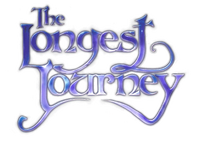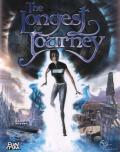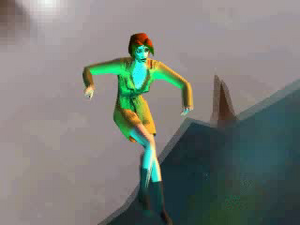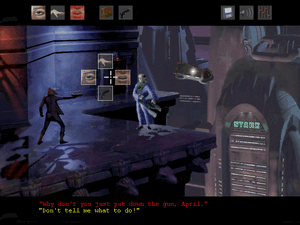

An adventure game produced by Norwegian developer Funcom, The Longest Journey is the first game of The Longest Journey Saga. It introduced us to April Ryan, a strong-willed heroine with a troubled past, and the twin worlds of Stark and Arcadia. April is troubled by nightmares, and strange events are happening in her quiet neighbourhood which are becoming harder to ignore. Guided by the mysterious Cortez, April discovers that the Balance, the powerful force that enables the twin worlds to exist, is in danger of failing because there is no Guardian in the Tower maintaining the Balance.
It falls upon April, a Shifter who can move between the worlds, to restore the Guardian and save the Balance (helped by her sidekick Crow). However, powerful forces contrive to stop her, with the Chaos Vortex, the Vanguard and their leader Jacob McAllen first among them. On her side are Cortez and the White Dragon.
The entire story is narrated by Lady Alvane, a mysterious figure whose tale brackets the game. April's journey takes her through a multitude of locations across the twin worlds and beyond, leading up to a climactic but ambiguous ending, which made fans eager for a sequel.
The title undoubtedly owes much to The Neverending Story (Die Unendliche Geschichte, 1979), by ironically-named German fantasist Michael Ende. It also tells the story of two worlds: our own, and one of fantasy.
The game and its creator Ragnar Tornquist were highly acclaimed as genre-savers, and put Funcom on the map. Although it was never a huge seller in any market, The Longest Journey (TLJ) gained a large and devoted fan-base that stubbornly stayed alive in the years after TLJ was released.
In 2011, it was announced that an iPhone port of The Longest Journey is in development.
Starting Points[]
Sequel[]
On the 27th of April 2003 a sequel to TLJ was announced, and on the 17th of April 2006 Dreamfall: The Longest Journey was released.
Release dates[]
- Norway: 19th of November, 1999
- Sweden: December, 1999
- France: December, 1999
- Germany: March, 2000
- United Kingdom: April, 2000
- United States: November, 2000
- Steam: 1st of May, 2007
Development (1996-1999)[]
Conception[]
After Funcom's work on Casper (Interplay Productions, 1996), they decided they would need to develop their own games to stay afloat. Other than Anarchy Online their former Dublin office (later closed) was developing another title known only as "Project X", about two worlds: one of science-fiction and one of fantasy. It was originally intended to be a platformer in the style of Heart of Darkness (Interplay Productions, 1998) called Split Realities.[1] But when Ragnar Tornquist, 25 at the time, took control of it he wanted to craft it in the style of his favourite adventure games: Day of the Tentacle (Lucasarts, 1993) and Gabriel Knight (Sierra, 1993). Adventure games may have already begun their decline but, as there was no real financial pressure, Tornquist began his swansong to the genre.
Ragnar later posted an excerpt from an early version of the story (27th March, 1996):
In her dreams that night there were angels and horses. With fierce, burning eyes, the white angels rode their black horses into the green pastures of an eerily familiar realm, and in their tracks all life withered. She knew the setting, yet she also knew she’d never consciously set foot in it before now. With the passing of the angels came a mighty roar, and darkness fell on that beautiful world.
In the darkness there was a face - a man’s face, bearing an uncanny likeness of herself, twisted through a mirror darkly. His eyes were cold, yet there was nothing evil about the man. He seemed just distant, dreamy, disinterested. As if pulled by unknown forces, she lifted her hand to touch the man’s face and felt her fingers touch her own face…
April woke with a start. The neon illumination of the big ‘Hotel 24hrs’ sign across the street added a ghostly sheen to the unfamiliarity of her bedroom. The sound of sirens overlapped in the night, and voices echoed through the grim corridors outside her door.[2]
(Tornquist later noted "The funny thing is how close a lot of what was written back then is to the next game's storyline.")
Two Directions, One Destination[]
From the beginning the game was about April living in the Border House, but at this time the world she lived in was much more dystopian as the staff were watching a lot of Dark City (1998). April's adventure began after repeated dreams of dark angels, and the other world was to be beautiful in contrast to the darkness of her own. Tornquist realised that, for the player to truly sympathise with April, he would have to have them participate at first in her ordinary world, and it must be at least partly recognisable to them.
This lead to a greater balance between the tone of both worlds, as the fantasy world incorporated some of the darker elements itself. April's Venice was modelled on New York's East Village, where Tornquist had lived while studying film at the Tisch School of the Arts at New York University from 1990-1993.
At this point he decided that he wanted to set April's world in our own time, but Didrik Tollefsen kept pulling her towards a more futuristic setting. This would allow the technological world to better contrast with the magical one, although Tornquist was careful not to let it descend into a Bladerunner (1982) pastiche. He has since reflected that the Stark sections of TLJ reflect the tension he felt between the two desired time periods, and some of this crept into the more recognisable technology of Dreamfall.
I'm Not the Chosen One You're Looking For[]
A more gentle dystopianism lingered in TLJ, however, in the form of the satirisation of Capitalism in such features as the privatised police force and rampant corporate warfare. This commentary was more organic than the deliberate themes such as that of 'faith' in Dreamfall, but faith and religion had a place in TLJ as well. Tornquist recalls:
"Games don’t often refer to religion. I was trying to make the whole idea of that universe co-exist with religion, having that story in the context of faith ... The Longest Journey is a game about finding yourself, and having belief in yourself, and conquering your personal demons, on a very simple level. It is also a game about having faith, and you have all these characters, like the Catholic priest, having him refer to the whole aspect of faith in relation to the unbelievable nature of split universes, and how you reconcile that with your own personal faith."
Even when the projected 18 months of development doubled and the budget began to blow out, Funcom stood by the game. TLJ was not always a carefully planned story, and Tornquist had not finalised the ending until relatively late in development.
"I think TLJ reflects the mind of a 25 year old, and Dreamfall is that of a 30-something. When you’re in your 20s, you don’t know where you’re heading, much like April. While in your 30s, maybe it is more about the loss of faith in yourself, faith in religion and faith in the world."
Originally April was meant to fill the role of "Chosen One", but Tornquist gradually became more and more disillusioned with this idea. He was reading Neil Gaiman at the time (especially the Sandman comics, 1989-1996) and watching a lot of Buffy the Vampire Slayer (1997-2003), and became influenced by the idea of a protagonist who is not the most important person in the world - but still has an important role to play. Tornquist puts this more realistic attitude as: "You’re only a cog, but... you can make a big difference."
Storytelling[]
Perhaps most importantly, TLJ is about storytelling. The entire game is bracketed by Lady Alvane's narration, and many of the characters advance the plot by telling their own stories. April must even read several books before she can continue her journey. Tornquist has said that character development is more important than - and even shapes - narrative. When writing the dialogue for TLJ Ragnar often only had a few lines written for each character, but after casting would allow the personality the actor brought to the part to shape the dialogue he wrote for them.
"Most of the dialogue for TLJ was written in a frenzy during the night. I stayed for two or three weeks in New York, and I did the writing at night until 3 or 4 in the morning. Then I went to bed, then printed it out on the crappy printer I bought, and then I’d hand them the new script pages."
This gave the actors plenty of freedom in their roles, and also lead to the many humorous out-takes accessible through the Book of Secrets. In the case of Andrew Donnelly the stand-up comedian who played Burns Flipper, this lead to plenty of colourful language, which drew the ire of a surprising number of players. "He was a good example of why it was a good thing I didn’t have someone standing over my shoulder while we made the game."
As an afterword, in comparison with Dreamfall Tornquist says:
"... it’s not as profound, but it has a simple joy that’s lacking in Dreamfall. It has a sense of exploration and adventure that’s lacking in Dreamfall, because Dreamfall is a lot more serious, and everybody’s questioning themselves, and everybody’s having a crisis of faith."
Further reading[]
External Links[]
References[]
| Chapters in The Longest Journey |
| Prologue: A Lion is in the Streets | Penumbra | Through the Looking Glass | Friends and Enemies | Monsters | There and Back Again | The Chaos Storm | A Deep Blue Mirror | Reunification | Shadows | Rebirth | Kin | Dreamland | The Longest Journey | Epilogue: Threads |








